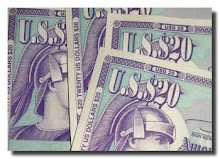CORPORATE STRATEGY AND POSITIVE NPV
The intuition behind discounted cash flow analysis is that a project must generate a higherrate of return than the one that can be earned in the capital markets. Only if this is true willa project’s NPV be positive. A significant part of corporate strategy analysis is seeking in-vestment opportunities that can produce positive NPV.
Simple “number crunching” in a discounted cash flow analysis can sometimes erro-neously lead to a positive NPV calculation. In calculating discounted cash flows, it is al-ways useful to ask: What is it about this project that produces a positive NPV? or Wheredoes the positive NPV in capital budgeting come from? In other words, we must be able topoint to the specific sources of positive increments to present value in doing discountedcash flow analysis. In general, it is sensible to assume that positive NPV projects are hardto find and that most project proposals are “guilty until proven innocent.”
Here are some ways that firms create positive NPV:
1. Be the first to introduce a new product.
2. Further develop a core competency to produce goods or services at lower cost thancompetitors.
3. Create a barrier that makes it difficult for other firms to compete effectively.
4. Introduce variations on existing products to take advantage of unsatisfied demand.
5. Create product differentiation by aggressive advertising and marketing networks.
6. Use innovation in organizational processes to do all of the above.
This is undoubtedly a partial list of potential sources of positive NPV. However, it isimportant to keep in mind the fact that positive NPV projects are probably not common.Our basic economic intuition should tell us that it will be harder to find positive NPV proj-ects in a competitive industry than a noncompetitive industry.
Now we ask another question: How can someone find out whether a firm is obtainingpositive NPV from its operating and investment activities? First we talk about how share prices are related to long-term and short-term decision making. Next we explain how man-agers can find clues in share price behavior on whether they are making good decisions.
Corporate Strategy and the Stock Market
There should be a connection between the stock market and capital budgeting. If a firm in-vests in a project that is worth more than its cost, the project will produce positive NPV, andthe firm’s stock price should go up. However, the popular financial press frequently sug-gests that the best way for a firm to increase its share price is to report high short-term earn-ings (even if by doing so it “cooks the books”). As a consequence, it is often said that U.S.firms tend to reduce capital expenditures and research and development in order to increaseshort-term profits and stock prices.1Moreover, it is claimed that U.S. firms that have validlong-term goals and undertake long-term capital budgeting at the expense of short-termprofits are hurt by shortsighted stock market reactions. Sometimes institutional investorsare blamed for this state of affairs. By contrast, Japanese firms are said to have a long-termperspective and make the necessary investments in research and development to provide acompetitive edge against U.S. firms.
Of course, these claims rest, in part, on the assumption that the U.S. stock market sys-tematically overvalues short-term earnings and undervalues long-term earnings. The avail-able evidence suggests the contrary. McConnell and Muscarella looked closely at the effectof corporate investment on the market value of equity.2They found that, for most industrial firms, announcements of increases in planned capital spending were associated with sig-nificant increases in the market value of the common stock and that announcements of decreases in capital spending had the opposite effect. The McConnell and Muscarella re-search suggests that the stock market does pay close attention to corporate capital spendingand it reacts positively to firms making long-term investments.
In another highly regarded study, Woolridge studied the stock market reaction to thestrategic capital spending programs of several hundred U.S. firms.3He looked at firms an-nouncing joint ventures, research and development spending, new-product strategies, andcapital spending for expansion and modernization. He found a strong positive stock reac-tion to these types of announcements. This finding provides significant support for the no-tion that the stock market encourages managers to make long-term strategic investment de-cisions in order to maximize shareholders’ value. It strongly opposes the viewpoint thatmarkets and managers are myopic.
Strategy and Analysis in Using Net Present Value
Saturday, March 1, 2008 At: 3/01/2008 10:19:00 PM by Joyce.gardner
Foreign
Exchange Calculator
|
||||||||
|
| Conversion : What do you want to convert to? |
Rates as of Fri Feb 29 18:05:03 EST 2008
Note: Rates may change throughout the day and may differ at the time
of booking. These rates apply to foreign exchange transactions with the
exception of the purchase and sale of currency notes (cash).

